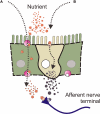The cornucopia of intestinal chemosensory transduction
- PMID: 20582275
- PMCID: PMC3112321
- DOI: 10.3389/neuro.21.003.2009
The cornucopia of intestinal chemosensory transduction
Abstract
The chemosensory transduction mechanisms that the gastrointestinal (GI) tract uses to detect chemical and nutrient stimuli are poorly understood. The GI tract is presented with a wide variety of stimuli including potentially harmful chemicals or toxins as well as 'normal' stimuli including nutrients, bacteria and mechanical forces. Sensory transduction is at its simplest the conversion of these stimuli into a neural code in afferent nerves. Much of the information encoded is used by the enteric nervous system to generate local reflexes while complementary information is sent to the central nervous system via afferents or by release of hormones to affect behaviour. This review focuses on the chemosensory transduction mechanisms present in the GI tract. It examines the expression and localisation of the machinery for chemosensory transduction. It summarises the types of cells which might be involved in detecting stimuli and releasing neuroactive transmitters. Finally, it highlights the idea that chemosensory transduction mechanisms in the GI tract utilise many overlapping and complementary mechanisms for detecting and transducing stimuli into reflex action.
Keywords: chemosensory; enterochromaffin cell; gastrointestinal tract; sensory transduction; serotonin.
Figures



Similar articles
-
The sense of taste in the upper gastrointestinal tract.Curr Pharm Des. 2014;20(16):2713-24. doi: 10.2174/13816128113199990569. Curr Pharm Des. 2014. PMID: 23886387 Review.
-
Review article: serotonin receptors and transporters -- roles in normal and abnormal gastrointestinal motility.Aliment Pharmacol Ther. 2004 Nov;20 Suppl 7:3-14. doi: 10.1111/j.1365-2036.2004.02180.x. Aliment Pharmacol Ther. 2004. PMID: 15521849 Review.
-
Serotonin release and uptake in the gastrointestinal tract.Auton Neurosci. 2010 Feb 16;153(1-2):47-57. doi: 10.1016/j.autneu.2009.08.002. Epub 2009 Sep 2. Auton Neurosci. 2010. PMID: 19729349 Review.
-
Bitter substances suppress afferent responses to an appetitive mixture: evidence for peripheral integration of chemosensory stimuli.J Neurobiol. 2001 Dec;49(4):255-63. doi: 10.1002/neu.10003. J Neurobiol. 2001. PMID: 11745663
-
Regulation of Ion Transport in the Intestine by Free Fatty Acid Receptor 2 and 3: Possible Involvement of the Diffuse Chemosensory System.Int J Mol Sci. 2018 Mar 5;19(3):735. doi: 10.3390/ijms19030735. Int J Mol Sci. 2018. PMID: 29510573 Free PMC article. Review.
Cited by
-
Enteroendocrine Cells: Sensing Gut Microbiota and Regulating Inflammatory Bowel Diseases.Inflamm Bowel Dis. 2020 Jan 1;26(1):11-20. doi: 10.1093/ibd/izz217. Inflamm Bowel Dis. 2020. PMID: 31560044 Free PMC article. Review.
-
Nutrient-induced changes in the phenotype and function of the enteric nervous system.J Physiol. 2014 Jul 15;592(14):2959-65. doi: 10.1113/jphysiol.2014.272948. Epub 2014 Jun 6. J Physiol. 2014. PMID: 24907307 Free PMC article. Review.
-
Gastrointestinal neuroendocrine peptides/amines in inflammatory bowel disease.World J Gastroenterol. 2017 Jul 28;23(28):5068-5085. doi: 10.3748/wjg.v23.i28.5068. World J Gastroenterol. 2017. PMID: 28811704 Free PMC article. Review.
-
Axon-like basal processes in enteroendocrine cells: characteristics and potential targets.Clin Transl Sci. 2011 Oct;4(5):387-91. doi: 10.1111/j.1752-8062.2011.00299.x. Clin Transl Sci. 2011. PMID: 22029814 Free PMC article. Review.
-
Bacteroides fragilis polysaccharide A is necessary and sufficient for acute activation of intestinal sensory neurons.Nat Commun. 2013;4:1465. doi: 10.1038/ncomms2478. Nat Commun. 2013. PMID: 23403566
References
-
- Bertrand P. P. (2006b). Real-time release of serotonin from mouse ileum. Gastroenterology 130(Suppl. 2), A256
LinkOut - more resources
Full Text Sources

